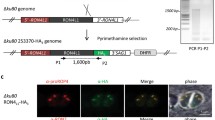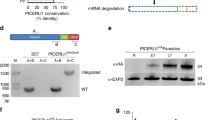Abstract
Immunoperoxidase localisation of antigen at the electron microscope level confirms that parasite surface proteins, in association with membrane, are shed from the surface of the zoite on invasion, while varying amounts are also internalised. SAG 1 is stable on intracellular zoites for up to 48h, although new protein is also synthesised. SAG1 is present on the surface of daughter zoites and is found throughout the infected cell in distinct vacuoles; these vacuoles represent either direct extensions of the parasitophorous vacuole or true export of parasite surface material.
Similar content being viewed by others
References
Aikawa M, Komata Y, Asai T, Midorikawa O (1977) Transmission and scanning electron microscopy of host cell entry byToxoplasma gondii. Am J Pathol 87:285–296
Aikawa M, Miller LH, Johnson J, Rabbege J (1978) Erythrocyte entry by malaria parasites. A moving junction between erythrocyte and parasite. J Cell Biol 77:72–87
Bannister LH, Buthcher GA, Dennis ED, Mitchell GH (1975) Structure and invasive behaviour ofPlasmodium knowlesi merozoites in vitro. Parasitology 71:438–491
Bommer W, Heunert HH, Milthaler B (1969) Kinemagraphische Studien uber die Eigenbewegung vonToxoplasma gondii. Z Tropenmed Parasitol 20:450–458
Couvreur G, Sadak A, Fortier B, Dubremetz JF (1988) Surface antigens ofToxoplasma gondii. Parasitology 97:1–10
Dubremetz JF, Rodriguez C, Ferreira E (1985)Toxoplasma gondii: redistribution of monoclonal antibodies on tachyzoites during host cell invasion. Exp Parasitol 59:24–32
Dubremetz JF, Achbarou A, Bermudes D, Joiner KA (1993) Kinetics and pattern of organelle exocytosis duringToxoplasma gondii host-cell interaction. Parasitol Res 79:402–408
Ferreira E, Dubremetz JF (1981) Etude ultrastructurale de l'invasion de la cellule hote parToxoplasma gondii. J Protozool 29:304
Grimwood J, Smith JE (1992)Toxoplasma gondii: the role of a 30 kDa surface protein in host cell invasion. Exp Parasitol 74:106–111
Madin SH, Darby NB (1958) Established kidney cell lines of normal adult bovine and ovine origin. Proc Soc Exp Biol Med 98:574–576
Michel R, Schupp M, Raether W, Bierther FW (1980) Formation of a close junction during invasion of erythrocytes byToxoplasma gondii in vitro. Int Journal Parasitol 10:309–313
Mineo JR, McLeod R, Mack D, Smith JE, Khan IA, Ely KH, Kasper LH (1993) Antibodies toToxoplasma gondii major surface protein (SAG-1, P30) inhibit infection of host cells and are produced in murine intestine after peroral infection. J Immunol 150:3951–3964
Nichols BA, Chiappino ML, O'Connor GR (1983) Secretion from the rhoptries ofToxoplasma gondii during host-cell invasion. J Ultrastruct Res 83:85–98
Pouvelle B, Spegel R, Hsiao L, Howard RJ, Morris RL, Thomas AP, Taraschi TF (1991) Direct access to serum macromolecules by intraerythrocytic malaria parasites. Nature 353:73–75
Rodriguez C, Afchain D, Capron A, Dissous C, Santoro F (1985) Major surface protein ofToxoplasma gondii (P30) contains an immunodominant region with repetitive epitopes. Eur J Immunol 15:747–749
Rudzinska MA, Trager W, Lewengrub SJ, Gubert E (1976) An electron microscopic study ofBabesia microti invading erythrocytes. Cell Tissue Res 169:323
Sibley LD, Krahenbuhl JL, Adams GMW, Weidner E (1986)Toxoplasma modifies macrophage phagosomes by secretion of a vesicular network rich in surface proteins. J Cell Biol 103: 867–874
Stephanini M, De Martino C, Zamboni L (1967) Fixation of ejaculated spermatozoa for electron microscopy. Nature 216:173–174
Torii M, Adams JH, Miller LH, Aikawa M (1989) Release of merozoite dense granules during erythrocyte invasion byPlasmodium knowlesi Infect Immun 57:3230–3233
Zgrzebski G, Raether W, Hofmann J, Entzeroth R (1993) Secretion of anEimeria tenella sporozoite antigen during host-cell invasion: visualization of the parasitophorous vacuole membrane and parasitophorous duct-like structures. Parasitol Res 79:77–79
Author information
Authors and Affiliations
Rights and permissions
About this article
Cite this article
Grimwood, J., Smith, J.E. Toxoplasma gondii: redistribution of tachyzoite surface protein during host cell invasion and intracellular development. Parasitol Res 81, 657–661 (1995). https://doi.org/10.1007/BF00931842
Received:
Accepted:
Issue Date:
DOI: https://doi.org/10.1007/BF00931842




